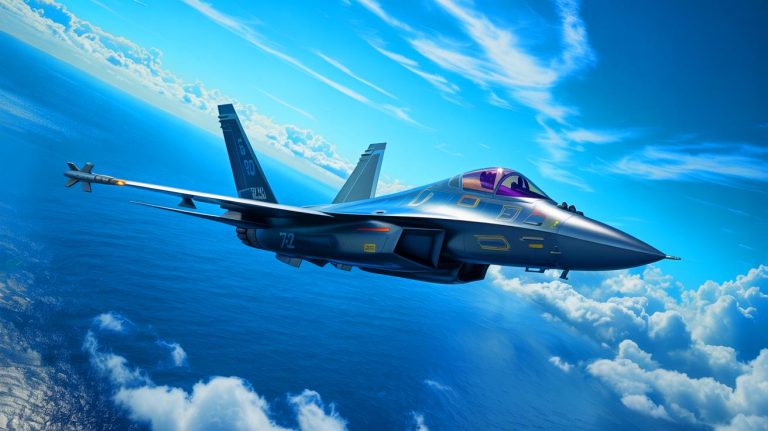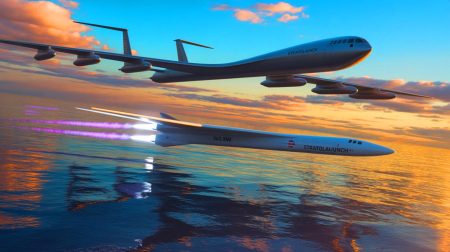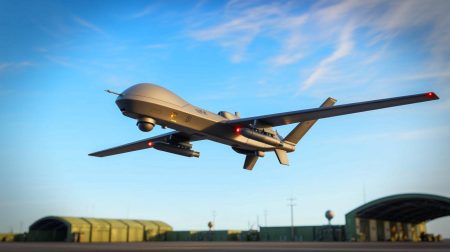| IN A NUTSHELL |
|
In the rapidly evolving landscape of global military capabilities, China is making significant strides with its development of the sixth-generation fighter jet, unofficially known as the J-36. This aircraft is poised to redefine airspace control in the western Pacific, particularly in the context of potential conflicts involving Taiwan. With the ability to enforce airspace blockades and counter advanced US military aircraft, the J-36 represents a critical component of China’s strategic military ambitions. This article delves into the capabilities and implications of the J-36, illustrating its potential impact on the balance of power in the Indo-Pacific region.
Locking Down Airspace for US
According to a report accessed by the South China Morning Post, the J-36 is designed to enforce airspace blockades for up to two hours at a combat radius of approximately 620 miles. This capability would effectively deny access to US military assets stationed in Guam, a strategic location for the United States in the Pacific. As Chinese military experts express concern over the People’s Liberation Army’s (PLA) current limitations against advanced US aircraft like the B-21 Raider stealth bomber, the J-36 emerges as a potential game-changer.
The current frontline fighter, the fifth-generation J-20, reportedly struggles to counter the B-21 due to constraints in range, payload, and situational awareness. The J-36, however, aims to bridge these gaps, providing China with a formidable tool to neutralize US air power in contested airspace. Such advancements could significantly alter military dynamics, challenging US dominance in the region.
Strategic Airspace Denial
The PLA envisions future aerial engagements concentrated around the first island chain, a crucial area within the 620-mile corridor from mainland China. Control of this airspace is vital in shaping the outcome of a Taiwan scenario. The J-36 is expected to perform deep interdiction missions, disrupting American attempts to project air power forward from Guam and other second-island chain positions.
The J-36’s mission profile includes the capacity to conduct short-duration airspace denial operations, suppress enemy air defenses from standoff ranges, and engage penetrating strike platforms like the B-21. This would complicate US efforts to assert air superiority and conduct joint force operations in support of Taiwan or other regional allies. The strategic deployment of the J-36 could shift the military balance in favor of China, raising the stakes in any potential conflict over Taiwan.
J-36 Capabilities
The J-36 incorporates several critical sixth-generation features that set it apart from its predecessors. It is estimated to be about 75 feet long and weigh between 99,200 and 119,000 pounds, significantly larger and heavier than the fifth-generation J-20. Key capabilities include full-spectrum stealth, an extended range facilitated by a tri-engine configuration, and a large internal weapons bay capable of carrying diverse munitions.
The side-by-side twin-seat cockpit architecture is designed to optimize manned-unmanned teaming (MUM-T), enabling real-time control of loyal wingman drones in complex air operations. Additionally, the platform’s significant onboard power generation capacity supports advanced electronic warfare (EW) systems, high-fidelity radar arrays, and network-centric data fusion. These elements are crucial for dominating multi-domain battle environments, offering fast cruise performance and improved pilot awareness.
US Plans
While the US has unveiled its sixth-generation fighter, the F-47, details remain limited. In contrast, the B-21 Raider, the world’s first operational sixth-generation bomber, has already conducted its maiden flight and is proceeding with serial production. Capable of an 8,000 km range, all-aspect stealth, and long-endurance loiter missions, the B-21 poses a significant threat to PLA air defenses, enforcing US access across the Pacific battlespace.
The J-36 is expected to enter service by 2030, potentially making China the first country to have an operational sixth-generation fighter. This development could shift the balance of power in the Indo-Pacific region, prompting US military planners to reassess the effectiveness of the country’s presence and deterrence strategies. The emergence of the J-36 underscores Beijing’s ambition to enhance its airpower and challenge US control beyond the first island chain.
As the J-36 progresses towards operational status, it raises critical questions about the future of military power dynamics in the Indo-Pacific region. With China poised to potentially outpace the US in deploying operational sixth-generation fighters, how will this impact the strategic calculus for both nations? Can the US effectively adapt its strategies to maintain its influence and support its regional allies amid these evolving challenges?
Did you like it? 4.6/5 (24)










Wow, the J-36 sounds like a game-changer! 🚀 How will the US respond to this new threat?
Can’t believe China might beat the US to the first operational sixth-gen fighter. Surprising!
Who names these jets? J-36 sounds like a new phone model, not a fighter jet. 😂
Isn’t this just another arms race in disguise? When will we learn? 🤔
Thanks for the detailed breakdown of the J-36’s capabilities. Very informative!
Are there any countermeasures the US can deploy to neutralize the J-36’s advantages? 🛡️
This is a wake-up call for the Pentagon. Time to step up game!
Could the J-36’s development lead to an increased risk of conflict over Taiwan?
Great analysis! But is the J-36 truly operational by 2030, or is it just hype?
What’s the significance of the 620-mile range mentioned for the J-36?
Spelling mistake in the article? It’s “defence” not “defense.” 😜
The tri-engine configuration is intriguing. What are the pros and cons?
How reliable are the sources claiming the J-36’s capabilities?
Seems like a lot of speculation. Is there any solid evidence of these claims?
Why does the Pentagon always seem shocked? Shouldn’t they expect this? 🤷♂️
The J-36’s stealth features sound impressive. Are they on par with the US’s stealth tech?
Appreciate the comprehensive coverage. Learned a lot about modern fighter jets!
Are there any international reactions to China’s J-36, besides the US?
This article gives me Star Wars vibes. Advanced tech everywhere! 🌌
The article mentions the B-21 Raider a lot. How does it compare to the J-36?
How does this affect US allies in the region? Are they worried too?
The J-36 could shift the balance of power. What’s the US’s next move?
Does the J-36 have any weaknesses, or is it the perfect fighter jet?
Is the side-by-side cockpit a new trend in fighter jet design?
Thanks for the insightful article. Makes me think about global power dynamics.
Sounds like a lot of military jargon. Can someone translate this for non-experts? 🤓
China and the US are like two kids in a sandbox. When will they play nice?
The J-36’s electronic warfare capabilities are concerning. How advanced are they really?
Is the J-36 development a response to the US’s F-47, or is it independent?
Why the urgency from the US? Haven’t they been working on similar tech?
What does this mean for the average person? More defense spending? 😩
Can the J-36’s presence deter the US from engaging in the region?
Interesting read! But how does this fit into the broader geopolitical picture?
Is the US falling behind in military tech, or is this just temporary?
How about a trade embargo .